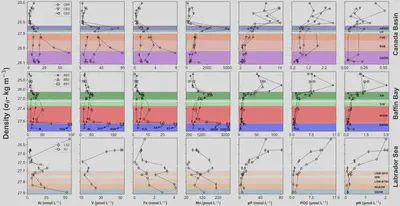Particulate trace element distributions along the Canadian Arctic GEOTRACES section: shelf-water interactions, advective transport and contrasting biological production

Abstract: Marine particles are important regulators of the biogeochemistry of many trace elements and isotopes in the ocean, and as such, there has been an increasing motivation to unravel the processes which control their cycling. Here, we present vertical distributions of total particulate trace elements (Al, V, Fe, Mn and P) and particulate organic carbon and particulate nitrogen (POC and pN) collected during the GEOTRACES Canadian cruise in 2015 in the Canada Basin (CB), the Canadian Arctic Archipelago (CAA), Baffin Bay (BB) and the Labrador Sea (LS), where particulate trace metal data are scarce. While particulate trace elements are generally affected by one-dimensional dynamics in ocean waters (e.g. deposition, scavenging/remineralization, and sinking), lateral transport of lithogenic-derived particles (pAl, pV and pFe) plays a dominant role in shaping their distributions in the deep CB, BB and LS basins. Higher concentrations of the aforementioned particulate trace elements are measured along the flow path of boundary currents and in near-bottom waters. Unlike pAl, pV and pFe, primarily controlled by lithogenic sources, bulk pMn distributions in our study regions (with the exception of LS) are dominated by authigenic Mn+3/4 oxides, with distinctively high concentrations in CB and BB subsurface halocline waters, as well as in the deepest samples in BB. Enhanced bacterially-mediated Mn+2 oxide formation is anticipated to occur in these halocline waters which have the potential to sustain large populations of Mn oxidizing bacteria as result of the close sediment-water interactions and distinct environmental conditions of these water masses. Overall, the highest concentrations of pP, POC and pN occurred in surface and near-surface waters (>100 m) at the same density as a chlorophyll-a peak and transmissivity drop, with a clear west-east increasing concentration gradient from the CB to LS. In summary, biogeochemical cycles of particulate elements in the Canadian Arctic Ocean are controlled by enhanced lateral transport and sediment resuspension (pAl, pFe and pV), authigenic formation of Mn and biological production (pP, POC and pN).